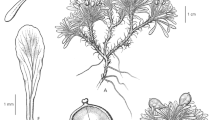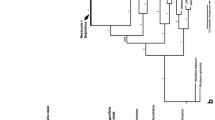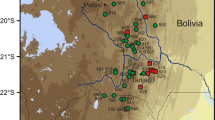Abstract
Six species recorded from Russia in the genus Bolbitius were studied. Among them, B. bisporus and B. pallidus are described as new in this paper. Comprehensive descriptions of all species, illustrations, photographs and comparisons with similar taxa are provided. Phylogenetic analyses were conducted to aid in taxa delimitation as well as identification of species boundaries in the genus Bolbitius. Molecular phylogenetic reconstructions inferred from maximum likelihood and Bayesian analyses were based on combined datasets: nrITS-nrLSU for the whole set of studied species and nrITS-tef1-mtSSU for B. titubans specimens. The molecular data of three genetic markers indicate the existence of at least three divergent lineages in B. titubans, and each may represent an independent taxonomic unit, which suggests that B. titubans is likely a species complex rather than one widely distributed taxon.












Similar content being viewed by others
References
Arnolds E (2005) Bolbitius Fr. In: Noordeloos ME, Kuyper TW, Vellinga EC (eds) Flora Agaricina Neerlandica, vol 6. CRC Press, Boca Raton, pp 112–119
Capella-Gutierrez S, Silla-Martinez JM, Gabaldon T (2009) TrimAl, a tool for automated alignment trimming in large-scale phylogenetic analyses. Bioinformatics 25:1972–1973. doi:10.1093/bioinformatics/btp348
Enderle M, Kajan E, Krieglsteiner GJ (1985) Studien in der Gattung Bolbitius Fries. Mitt Arbeitsgem Pilzk Niederrhein 3:5–34
Fries EM (1838) Epicrisis Systematis Mycologici, seu Synopsis Hymenomycetum. Typographia Academica, Uppsala, 1836
Gardes M, Bruns TD (1993) ITS primers with enhanced specificity for basidiomycetes - application to the identification of mycorrhizae and rusts. Mol Ecol 2:113–118
Hausknecht A, Contu M (2006) Bolbitius demangei in Italien. Österr Z Pilzk 1:7–10
Hongo T (1958) Notes on Japanese larger fungi (12). J Jpn Bot 33:41–48
Katoh K, Toh H (2008) Recent developments in the MAFFT multiple sequence alignment program. Brief Bioinform 9:286–298. doi:10.1093/bib/bbn013
Kornerup A, Wanscher JH (1978) Methuen Handbook of Colour, 3rd edn. Eyre Methuen, London
Matheny PB, Curtis JM, Hofstetter V et al (2006) Major clades of Agaricales: a multilocus phylogenetic overview. Mycologia 98(6):982–995
Moncalvo JM, Vilgalys R, Redhead SA, Johnson JE, James TY et al (2002) One hundred and seventeen clades of euagarics. Mol Phylogenet Evol 23:357–400
Rehner SA, Buckley E (2005) A Beauveria phylogeny inferred from nuclear ITS and EF1-a sequences: evidence for cryptic diversification and links to Cordyceps teleomorphs. Mycologia 97:84–98
Ronquist F, Huelsenbeck JP (2003) MrBayes version 3.0: Bayesian phylogenetic inference under mixed models. Bioinformatics 19(12):1572–1574. doi:10.1093/sysbio/sys029
Singer R (1951) The Agaricales (Mushrooms) in modern taxonomy. Lilloa 22:1–832
Tamura K, Stecher G, Peterson D, Filipski A, Kumar S (2013) MEGA6: Molecular Evolutionary Genetics Analysis Version 6.0. Mol Biol Evol 30:2725–2729. doi:10.1093/molbev/mst197
Tóth A, Hausknecht A, Krisai-Greilhuber I, Papp T, Vágvölgyi C, Nagy LG (2013) Iteratively refined guide trees help improving alignment and phylogenetic inference in the mushroom family Bolbitiaceae. PLoS ONE 8:e56143. doi:10.1371/journal.pone.0056143
White TJ, Bruns T, Lee S, Taylor JW (1990) AmpliWcation and direct sequencing of fungal ribosomal RNA genes for phylogenetics. In: Innis MA, Gelfand DH, Sninsky JJ, White TJ (eds) PCR Protocols: A Guide to Methods and Applications. Academic Press, New York, pp 315–322
Watling R (1982) British Fungus Flora. Agarics and Boleti 3. Bolbitiaceae: Agrocybe, Bolbitius and Conocybe. HMSO, Edinburgh
Acknowledgments
We are grateful to Dr. Yu. Rebriev (Institute of Arid Zones at the Southern Scientific Center, Russian Academy of Science, Rostov-on-Don, Russia) for kindly providing some photographs. This study was funded by the Russian Foundation for Basic Research (project no.13-04-00838). The morphological data analysis was carried out within the framework of the institutional research project (no. 01201255602) of the Komarov Botanical Institute of the Russian Academy of Sciences.
Author information
Authors and Affiliations
Corresponding author
Additional information
Section Editor: Zhu-Liang Yang
Rights and permissions
About this article
Cite this article
Malysheva, E.F., Malysheva, V.F. & Svetasheva, T.Y. Molecular phylogeny and taxonomic revision of the genus Bolbitius (Bolbitiaceae, Agaricales) in Russia. Mycol Progress 14, 64 (2015). https://doi.org/10.1007/s11557-015-1087-2
Received:
Revised:
Accepted:
Published:
DOI: https://doi.org/10.1007/s11557-015-1087-2




